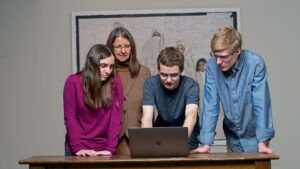My initial inspiration for the Artful Recommender Project came from art at Lafayette, so my work includes a focus on building recommenders for small galleries, museums and outdoor exhibits that may not have the patrons or artworks to create extremely large datasets of ratings to drive the recommender.
Collaborative filtering recommendation systems use ratings of products by many users to recommend products to a specific user. There are many techniques for doing this including recommending products that are similar to products the user has liked in the past, or recommending products liked by users with similar preferences. Most people have encountered the Amazon Recommender which lists recommended items under the heading “Customers Who Bought This Item Also Bought.” These systems are limited to static recommendations. They do not consider the dynamic aspects of experiences such as whether the experience is crowded.

Artful Project Team from left to right: Nicole Kaplan ’20, Professor Ordille, Ezekiel Elin ’20, Ben Fuller ’21
Have you ever visited a museum exhibit too crowded to enjoy when another equally enjoyable exhibit was uncrowded down the hall? Have you ever wished your day-to-day walk to class or drive to work could expand to take in momentary nearby delights? The goal of my research at Lafayette is to extend recommendation systems to suggest immediate, enjoyable, uncrowded experiences to you. My student research group pictured above calls this effort: Recommending Unrealized Happiness.
In part, the Artful Project collects ratings of digital images of art. Our team extended a game system for labeling photographs in Lafayette’s Art Collection that was originally created by the Senior Project Team of Agathe Benichou, Liam Mungovan, Nick Turney and Andrew Ortiz in 2018. A brief look at the Artful labeling and rating software is supplied in the video below.
